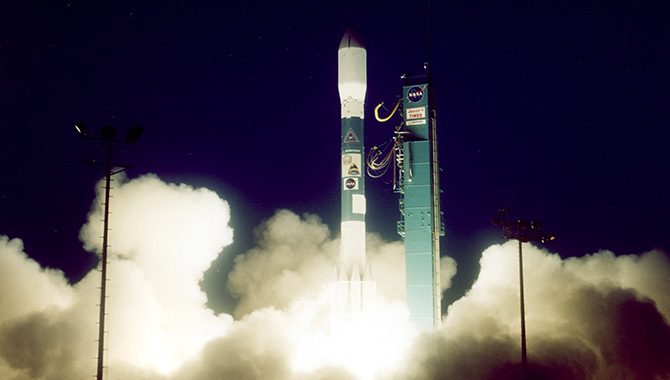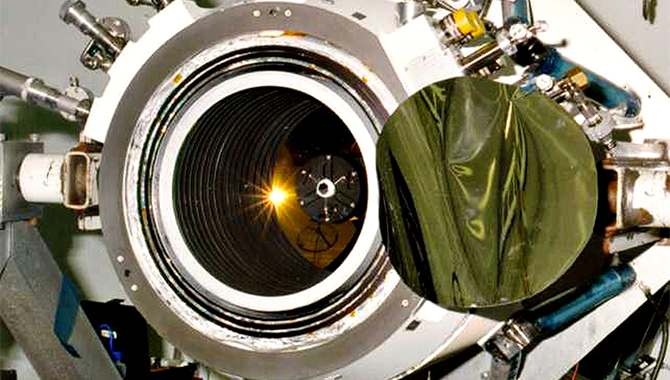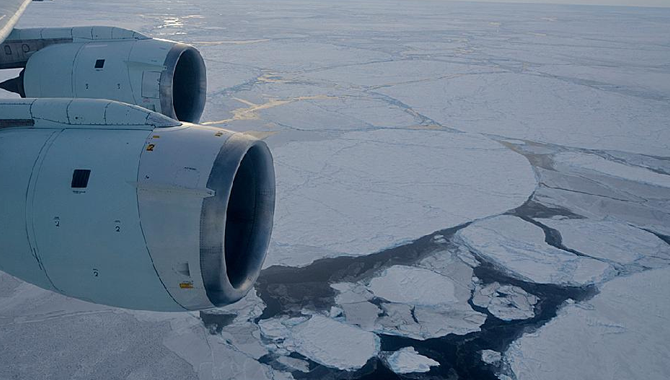
A Delta II launch vehicle carrying the TIMED spacecraft as well as the NASA/CNES Jason-1 satellite prepared to lift off from Vandenberg Air Force Base, California, on December 7, 2001.
Photo Credit: The Boeing Company
Fifteen years ago, NASA’s TIMED spacecraft rode a Delta II rocket into the least-understood region of Earth’s atmosphere.
Between 40 and 110 miles above Earth lies a section of the atmosphere called the Mesosphere and Lower Thermosphere/Ionosphere (MLTI). The chemical and thermal balance of this region reacts strongly to external factors, such as changes in the amount of solar energy entering Earth’s environment or increases in gases like methane and carbon dioxide due to human activities on the ground. Changes in the MLTI impact the performance of satellites, GPS technology, and high-frequency radio communications, and can affect spacecraft orbits and crewed reentry planning.
Scientists believed that shifts in the region’s energy balance could provide early warning of global atmospheric changes—but only if there were a way of understanding and tracking them. This led to the development of Thermosphere, Ionosphere, Mesosphere, Energetics and Dynamics (TIMED): the first mission designed to conduct a comprehensive study of the MLTI. TIMED’s primary objectives were to better understand MLTI structure and dynamics, and provide a baseline for future comparison so that changes in the region could be measured.
Development began at Goddard Space Flight Center (GSFC), which was awarded the mission in 1990. TIMED was originally envisioned as the first element in a large, multi-spacecraft program utilizing as many as 15 instruments to address 25 science requirements at a cost of roughly a billion dollars overall. TIMED, specifically, would feature two high-altitude spacecraft and a “dipper” that would reach down into the lower regions of the atmosphere. Before this aspirational vision could be realized, administrative changes and budgetary constraints ate away at the scope of the mission. TIMED’s budget fell from an estimated $300 to $450 million to $100 million. The science requirements dropped to two: structure (temperature, density, and wind) of the MLTI and energy balance. The dipper spacecraft was eliminated. Finally, three years after initiating the project, GSFC concluded the mission had been so altered that it was no longer an appropriate match for the center. The project team was disbanded and development ceased.
NASA Headquarters (HQ) remained interested in the project and in 1994 approached the Johns Hopkins University (JHU) Applied Physics Laboratory (APL) about developing a small, low-cost MLTI study. Experienced in running small scientific missions, APL spent the next two years pushing the single-spacecraft/four-instrument mission forward while NASA HQ provided program management. But in 1996, the mission had to be shifted again when the agency decided that HQ would no longer manage programs directly. Instead, GSFC was once again called upon to manage TIMED, while APL designed, built, and operated the spacecraft. Given that both organizations had once maintained full responsibility for the mission, interactions between the APL-based project office and the GSFC-based mission office were strained. Distinct cultural differences between the two institutions underscored the challenges.
Tensions eased somewhat when TIMED was put under GSFC’s Solar Terrestrial Probes (STP) Program in 1999, not long before the planned launch in January 2000. But that launch never took place. The problem was not with TIMED: the spacecraft and team were ready to go. The issue was with another project entirely: Jason-1, a joint NASA/Centre National d’Etudes Spatiales (CNES) ocean altimetry satellite. TIMED and Jason-1 were scheduled to share a ride on a Delta II rocket out of Vandenberg Air Force Base in California. Due to problems with Jason-1, the launch was delayed repeatedly over the next two years, contributing to a 10% cost overrun for TIMED.
It wasn’t until December 7, 2001, that TIMED finally lifted off to explore the MLTI. Even then, the mission’s troubles weren’t quite over. Within the next few months, four anomalies occurred, including a wheel failure. Nonetheless, science operations began on January 22, 2002, and the mission met its minimum requirements. After completing the original two-year mission, TIMED was extended in 2003 and then five additional times. The spacecraft still flies today, its current mission continuing through 2017.
TIMED has now operated through a full sun cycle, with research findings documented in more than 1,700 scientific papers. On August 15, 2016, the mission celebrated more than 5,000 days of ongoing data collection in orbit. Given its 15-year presence in the MLTI, TIMED has been able to identify long-term trends in the region, including a sharp increase in carbon dioxide levels in the upper atmosphere marked by greater accumulation over the Northern Hemisphere.
TIMED was designed, built, and operated by APL, which also leads the mission’s science efforts. Managed by GSFC, TIMED is the first mission in NASA’s Heliophysics STP Program, which seeks to understand fundamental physical processes in the solar system.
Read an APPEL/GSFC case study presenting TIMED lessons learned.
Learn more about significant findings from the TIMED mission in this video.









